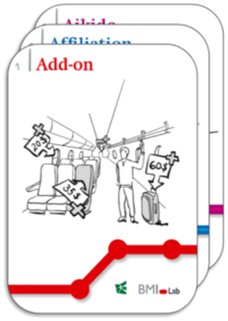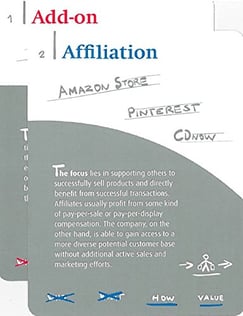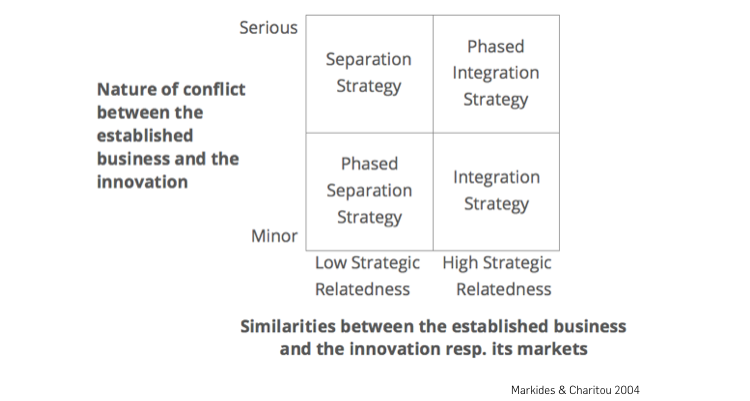Business Model Innovation: Which Method Is Right?
Despite the advantages of business model innovations, there is a lack of systematic methods for their implementation. Learn how to combine proven methods to successfully develop new business models.

Despite the numerous advantages and high complexity of business model innovations, there are hardly any methods and tools for systematically planning and implementing them. You can find out which proven methods you can combine in the context of business model innovation in order to visualize existing business models, generate ideas for new business models, and implement them in this blog entry.
Methods for visualizing and evaluating business models
To kickstart the process of creating a new business model, it is crucial to first visualize and thoroughly evaluate the current business model through stress tests. This step lays the foundation for identifying areas of strength, weakness, and potential improvement within the existing framework. By conducting stress tests, businesses can gain valuable insights into the resilience and adaptability of their current model, setting the stage for innovation and growth.
Graphical representation of the current business model
Depending on the degree of detail required, the business model can be carried out using the business model navigator concept of the University of St. Gallen, as well as by the globally known method of the business model canvas by Alexander Osterwalder and Yves Pigneur.
The Business Model Navigator describes the business model from a meta-perspective using four dimensions:
- Who are the target customers?
- What is the benefit?
- How is the benefit created and delivered?
- How does the company earn money?
The method is less detailed than the Business Model Canvas and is suitable as an introduction to the topic, especially if a company has never been in contact with business model innovation or the timeframe for conducting an analysis is very narrow.
For a deeper insight into the business model, the Business Model Canvas concept is the method of choice, but at the latest when it comes to designing a new business model or testing, you should work with the Business Model Canvas. It is somewhat more comprehensive than the a before mentioned 4-dimension concept and allows a higher degree of complexity and detail. It describes the business model in nine blocks that cover both the offer page (customer segments, value promises, customer channels, customer relationships, revenue structure) and the area of the infrastructure (key resources, activities, partners, cost structure). You can download a template here.
Stresstest: Where is the need for action?
In a further step, the individual areas are evaluated on the basis of the visualization of the business model, strengths and weaknesses are worked out and critical factors identified.
The business model, however, can not be viewed in isolation from its environment. Therefore, relevant trends in the areas of market, industry, technology, legislation and society are analyzed by means of employee and expert discussions, as well as primary and secondary research, and their impact on the business model is analyzed.
The graphical representation in the form of a trend radar makes the environmental analysis more tangible. The business model is located in the middle of the trend radar, the various trends from the various areas are arranged around the scenes:
- Impact of the trend on the business model: The more the impact of the trend, the greater the point in the trend radar.
- Time relevance: The earlier the trend becomes relevant for the company, the closer to the center the trend is arranged.
Methods for generating business model innovation
There are a variety of approaches to the development of new business models. We present you three tried and tested methods, which are used in parallel, as they complement each other and examine the company from different perspectives for possible innovations:
| Method | Focus |
| Scenario technique | Market and market trends (basis: trend radar) |
| Customer experience | Needs of customers |
| Creative imitation | Existing business models |
The scenario technique - business model innovation based on trends
Out of the trends that have hit the trend radar and at the same time influence the business model to a great extent, alternative scenarios are derived, each of which represents different manifestations of the trends. A business model is then developed for each of the scenarios. Changes in the business environment can therefore be anticipated and addressed at an early stage.
The company can actively begin to implement the business model that it believes will be relevant in the future. Alternatively, there is the possibility to react in a reactive manner by observing the market and not taking the business model out of the loader until the market goes in the projected direction.
Customer Experience Design - Focus on customer needs
This approach, which is based on marketing, focuses on the specific needs of individual customer groups. A wallpaper manufacturer, for example, supplies wholesale markets, DIY markets such as Obi and Baumax or painters who shop directly. For each of these customer groups, a "Customer Experience Design" is now being created with selected customers, which documents all the points of contact and problems of this customer with the company during a customer journey. In this way, it is possible to reveal approaches to improve the customer experience, from which new tailor-made business models can be developed:
- Select a specific target group
- Detailed graphical description of the customer journey (Customer Journey)
- Description of the touch points and systems "on stage" (personal or other contact with a person) and "backstage" (e.g., an app that supports in the background, but no personal contact occurs.)
- Adding the customer preference
- Identification of problems and opportunities
In particular, companies with homogeneous customer requirements are benefiting from this approach as the creation of a "customer experience design" can create the transparency for each customer group that makes it possible to identify the needs and the expected benefits of the different customer groups.
Creative imitation of existing business models
According to a study by the University of St. Gallen, over 90 percent of all business model innovations are based on the recombination of 55 business model patterns. Through creative imitation, these business model patterns are systematically applied to their own company using Patterncards and the Business Model Navigator.
You can either proceed according to the similarity principle and apply those pattern cards to your own business model, which are most similar to it. Or, according to the contrast principle, one chooses pattern cards that have very little to do with their own business model. This may seem completely hopeless with some pattern cards, but in others, business models with a high degree of innovation are created. This approach therefore calls for an approach that basically believes everything possible, killer phrases in the sense of "with us it is certainly not" destroy valuable chances for innovative business models.


Photo: Patterncards of the BMI Lab St. Gallen
To support the process, the areas of the Business Model Navigator, which are changed, are displayed on the back of the pattern cards. In the "Affiliation" example shown here, the dimensions "How is the benefit created and delivered" and how does the company earn money?
Subsequently, the generated business model alternatives are tested for their fit to the company, the most suitable selected and then tested and sharpened in a next step.
Methods for testing and implementing new business models
Discovery driven learning & prototyping
Ideas, but not business models, are created on the drawing board. A market-ready business model must be further developed and sharpened directly in the market. Discovery driven learning through Trial and Error is therefore at the core of this phase, where it is a question of cost-effectively testing the selected business model ideas based on the business model prototypes and hypotheses, making them more marketable and ultimately more marketable. Instead of extensive business plans and market research, this is about the fast and practical knowledge gained.
Implementation strategy: Internal versus external implementation
With the help of Professor Markides' approach, it is possible to determine how the business model alternatives are to be introduced into the market. The framework is based on two dimensions, from which four basic implementation strategies can be derived.
- Conflict potential with the existing business model (nature of conflict)
- Synergy potential with the existing business model (similarities)

- Separation Strategy: In the case of high conflict potential and low synergy potential, it makes sense to break down the business model alternative as a separate business unit. The potential disadvantage is a lack of resources, since an entire company has to be re-established.
- Integration Strategy: With high synergy potential and low potential potential, the business model alternative can be implemented via the internal R & D department. The disadvantage of this variant is less flexibility since the patterns of the existing business model can block new paths.
- Phased Separation Strategy: Due to the high synergy potential, the business model innovation is initially implemented in the company and then gradually outsourced.
- Phased Integration Strategy: Due to the high anticipated potential for conflict, the business model innovation is initially founded and then re-integrated into the company in several phases.
Conclusion: Gradual sharpening through trial and error brings success
No matter what creativity-methods you use to generate business model alternatives - the most important method in the business model innovation process is trial and error testing in the market. Cost-effective business model prototypes in conjunction with the right customers and continuous testing using hypotheses form the decisive basis for successful business model innovation.
Tip: Try the method finder to find the right innovation method for your situation. With this free tool, you can assess your initial situation and receive tips for the next step in your innovation project.











